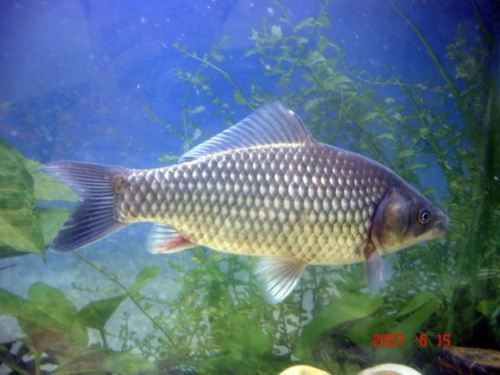Higher classification Carassius | Phylum Chordata Scientific name Carassius gibelio Rank Species | |
 | ||
Similar Carassius, Crucian carp, Common rudd, Common nase, Tench | ||
Fishing prussian carp one fish every minute pecanje babuske giebel
The Prussian carp, silver Prussian carp or Gibel carp (Carassius gibelio, sometimes Carassius gibelio gibelio and, before 2003, Carassius auratus gibelio), is a member of the family Cyprinidae, which includes many other fish, such as the common carp, and the smaller minnows. It is a medium-sized cyprinid, and does not exceed a weight of 6.6 pounds (3 kg) and a size of 45 cm. They are usually silver, although other color variations exist. They are omnivorous and feed on plankton, invertebrates, plant material and detritus. Originally from Asia (Siberia), they have been introduced to and are now inhabiting lakes, ponds, and slow-moving rivers throughout Europe, North America, and Asia.
Contents
- Fishing prussian carp one fish every minute pecanje babuske giebel
- Prussian carp in the bow river invasive species
- Description
- Domestication into Goldfish
- References
Prussian carp in the bow river invasive species
Description

The Prussian carp is a deep-bodied, robust fish which resembles the Crucian carp (Carassius carassius) and grows to about 10 to 35 cm (4 to 14 in) in length. Its scales are larger than those of the Crucian carp, and it typically has 27 to 32 scales along the lateral line, whereas the Crucian carp usually has between 31 and 35. The species is silvery, sometimes with a faint golden tinge, while the Crucian carp has a burnished gold appearance. The Prussian carp's tail is more deeply forked than that of the Crucian carp.
Domestication into Goldfish

Goldfish were originally developed from domesticated Prussian carp in China over 1,000 years ago, when they were bred for color for display in ornamental ponds and watergardens. Although some sources claim that crucian carp (Carassius carassius) are the wild version of the goldfish (Carassius auratus), recent research has found that the wild form of the goldfish is actually the Prussian carp (Carassius gibelio, or sometimes C. auratus gibelio, with gibelio identified as a subspecies of C. auratus). While they are certainly closely related, and often confused, they are different species, and can be identified by the following characteristics:
